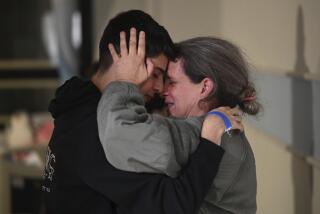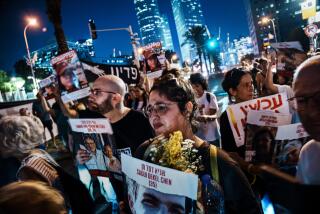Some Hostages Moved to Bekaa Valley, CIA Suspects
- Share via
WASHINGTON — The CIA “has strong reason to believe” that some of the American hostages from TWA Flight 847 were moved last week to the pro-Iranian stronghold of Baalbek in the Bekaa Valley of eastern Lebanon, U.S. officials said Monday.
If the intelligence report proves true, it would be a new piece of evidence linking the hijackers of the plane at least indirectly to the regime of the Ayatollah Ruhollah Khomeini, the officials said.
But the United States has found no “smoking gun” yet that would prove direct Iranian participation in the hijacking, they said.
“We’ve been looking,” a State Department official said, “but it isn’t that easy.”
The hijackers, who are believed to be members of the pro-Iranian Hezbollah, or Party of God, may have moved the hostages from Beirut to Baalbek to protect their headquarters there against U.S. attack, a source with access to CIA reports said.
The movement of some of the hostages to Baalbek was also reported Monday by the radio station of Lebanon’s Christian Falangist Party, which has its own intelligence service. The broadcast said the hostages were in the Sheik Abdullah army barracks, which is held by Hezbollah gunmen.
Such a move, putting some of the American captives 45 miles northeast of Beirut, would greatly complicate any attempt to rescue them in a military operation.
The CIA hopes to determine the hostages’ location with more certainty, one source said.
President Reagan’s national security adviser, Robert C. McFarlane, said last week that the Administration believes that Hezbollah holds six or seven of the 40 hostages--a group that, according to other officials, is believed to include some U.S. military personnel and some men whose names apparently sounded Jewish to the hijackers.
In the spectrum of Shia Muslim political movements in Lebanon, Hezbollah is more radical and closer to Khomeini than the relatively moderate Amal movement led by Nabih Berri, who claims to hold 30 or 31 of the hostages. The other three hostages, members of the TWA jet’s crew, are still being held aboard the plane by unidentified terrorists.
Defense Secretary Caspar W. Weinberger said Monday that the government has not yet determined who planned the June 14 hijacking.
“At the beginning, when the hijacking took place just outside of Athens, it was a pretty standard hijacking: A couple of people with pistols that they smuggled aboard held up the plane and forced it to go to Beirut,” Weinberger said in an interview with television correspondents.
Joined by Others
“After that, these people were joined by a large number of their fellow terrorists, and the problems we’re all familiar with developed. Whether there was any kind of concerted plan to do it that way or not, none of us know at this time.”
Some government analysts argue that the initial hijacking of Flight 847 on June 14 was carried out not by Hezbollah or Amal but by a “free-lance” team of terrorists, perhaps drawn from members of one or both organizations. According to this theory, the rival Shia militias only entered the picture when the hijackers brought their plane repeatedly to Beirut, unloading their hostages in two separate groups.
“It didn’t look well-orchestrated,” one official said of the initial hijacking. “Iranian-sponsored operations tend to be very well-orchestrated and prepared. These guys took over the plane and then didn’t seem quite sure what to do with it.”
Evidence of Complicity
He said the fact that the hijackers were willing to deal with Berri was another sign that Iran may not have been involved from the start. “The Iranians wouldn’t do it in such a way as to strengthen Berri’s political position,” the official said.
He said the United States has “ample evidence” of Iranian complicity in several other terrorist attacks, including the bombing last Sept. 20 of the U.S. Embassy annex in East Beirut, responsibility for which was claimed by the faction calling itself Islamic Jihad (Islamic Holy War).
Intelligence analysts have been sifting pieces of evidence such as the pattern of visits to Baalbek by officers of the Iran’s paramilitary Revolutionary Guards, which has a small garrison in the Lebanese city and has reportedly been a conduit for Iranian funding and training of Hezbollah guerrillas.
Visit by Two Officers
Two ranking Revolutionary Guards officers allegedly visited Baalbek on June 10, only four days before the hijacking, one source said.
The Iranian Cabinet minister in charge of the Revolutionary Guards, Mohsen Rafiqdost, was in Damascus, Syria, on Monday as part of a visiting delegation led by the Speaker of the Iranian Parliament, Hashemi Rafsanjani.
Rafsanjani denied that his country had anything to do with the hijacking. “Iran had no connection whatsoever with this incident, and had it known in advance of the hijack and of the identity of the hijackers, it would have prevented it,” he told a news conference.
A U.S. official dismissed Rafsanjani’s denial as “worthless.”
“They’ve denied operations that we had absolutely clear evidence on,” he said.
More to Read
Sign up for Essential California
The most important California stories and recommendations in your inbox every morning.
You may occasionally receive promotional content from the Los Angeles Times.











